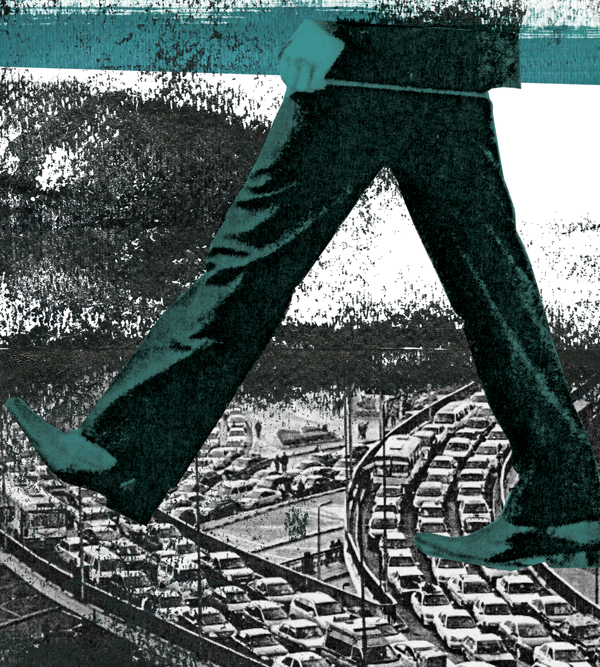Illustration by Kathleen White
Car Culture Calculus
by Jerry Silberman
Question: What is best for the environment—a fuel-efficient internal combustion car, hybrid, or electric car?
The Right Question: Is driving, regardless of the car, the biggest threat to the environment?
When it comes to evaluating a car, we tend to look at how much gasoline (or electricity) it will use as the sole measure of how it contributes to carbon emissions. But cars aren’t hatched, and when you are finished with them, you can’t compost them. How much energy and material will be used from the time a car starts its roll down the assembly line until it is finally scrapped, and at least partially recycled? It turns out that regardless of how your car is powered, the life cycle energy consumption is pretty much the same.
The MIT Energy Laboratory calculates that an internal combustion engine (ICE) car’s gasoline energy consumption is equal to the energy required to build the car when you have driven approximately 150,000 miles. The energy used to build (and dismantle) your electric car is two to three times higher than the ICE, while the energy used to move it around is about the same. However, depending on the source of the electricity, it may result in fewer greenhouse gas emissions.
But the vehicle itself is only part of the question. Living in a society so accustomed to—and dependent upon—driving, it’s easy to forget the massive amount of infrastructure that cars require. According to PennDOT, there are approximately 119,000 miles of asphalt and concrete surfaced highways in the Commonwealth of Pennsylvania. That’s the same area as Philadelphia, Montgomery and Delaware counties, all of it land withdrawn from photosynthesis and unavailable to soak up stormwater runoff, which also causes erosion.
Producing cement (48 million tons embedded in the Interstate Highway System) annually accounts for five percent of CO2 released by human technology. Building one lane of highway, one kilometer long, uses the energy equivalent of 23,000 gallons of gasoline. PennDOT alone has over 2,000 heavy maintenance trucks, and uses one million tons of salt annually.
That said, most Americans are unable to conduct daily business without a car, so what’s a civic-minded driver to do? In the long term, we can insist on better planning for our cities and invest in infrastructure that supports our public transit system.
In the short term, we can change our habits, and let’s be real and honest about it: Even the few of us who are able to consciously structure our lives so as not to use a car, or use one only rarely (a choice your author makes), mostly we pretend that a convenience is a necessity, and we rationalize driving by seeking only to answer the Big Question I began with.
We can also change our mindset. As I walk or bike around the city, or bus or train around the region, I am always rewarded (even if my trip takes longer) by realizing how much more there is to see and think about when I don’t have to focus on the asphalt in front of me.
In the end, an examination of the life cycle, energy and material use of a vehicle and its constructed environment tells us that no car, unfortunately, is friendly to the environment. But to answer the original question: Avoid buying a new car, and drive what you have as long as possible. The longer you keep your car on the road—regardless of its flavor—the less damage is done to our ecosystem.
Jerry Silberman is a cranky environmentalist and union negotiator who likes to ask the right question and is no stranger to compromise.









Excellent, and thanks. Whether cars run on oil, nuclear electricity or pixie dust, they rely on roads that enable humans to spread across fertile land and wild places. Our better destiny is to rebuild civilization so that cities function easily without cars. My 1982 book introduces this process http://www.paulglover.org/lahofbook.html See also Carfree Philly http://www.paulglover.org/carfreephilly
I certainly agree with your conclusions about the costs & destructiveness of maintaining infrastructure for cars. The concrete that goes into roads is just the beginning; there’s also the question of how we design our communities – prioritizing cars, or humans and other living beings. That said, the Union of Concerned Scientists concludes that electric cars are in fact cheaper over a good long life – see http://www.ucsusa.org/publications/ask/2014/lifecycle-emissions.html#.VkT3FkV3a2x.